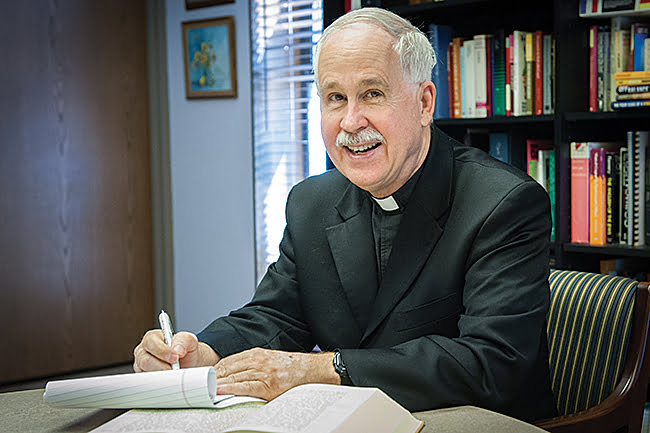
Father Mike Stubbs is the pastor of Holy Cross Parish in Overland Park and has a degree in Scripture from Harvard University.
by Father Mike Stubbs
Have you ever seen someone whose face is glowing, who looks radiant with joy?
Perhaps they have just heard good news. Maybe they have attained a long-awaited dream. They have just learned that they are going to have the baby they have been hoping for. Or maybe they are going to receive the scholarship they have applied for. In any case, their outward appearance reflects their inner happiness.
Something along those lines happens in Sunday’s Gospel reading, Lk 9:28b-36, but with much greater intensity than we have ever experienced. When Jesus goes up the mountain, he is transfigured in glory: “His face changed in appearance and his clothing became dazzling white.”
This event in Jesus’ life is described in all three synoptic Gospels — Matthew, Mark and Luke — but Luke’s version differs from the others in an important respect.
He specifies the purpose in Jesus’ going up the mountain with Peter, James and John: to pray. The transfiguration occurs during an experience of prayer: “While he was praying his face changed in appearance.”
Throughout his Gospel, Luke emphasizes the element of prayer in Jesus’ life. For example, all three synoptic Gospels also describe Jesus’ baptism, but only Luke similarly places it during Jesus’ prayer (Lk 3:21).
Prayer brings us into communion with God. At times, that means that we can then sense God’s presence. We can feel God’s love for us.
As the Son of God, Jesus was always connected to the other two persons of the Holy Trinity. At the same time, as a human being, prayer helped Jesus to experience that communion with them. That is why Luke so often mentions Jesus as spending time in prayer.
When Jesus is transfigured on the mountain, his glory which is revealed at that moment reflects his communion with God through prayer, the joy that he felt. The voice from heaven confirms that communion: “This is my chosen Son; listen to him.” The transfiguration results from Jesus’ experience of prayer.
Jesus goes up the mountain to pray, but he does not go alone. He takes Peter, James and John with him. Luke’s Gospel does not tell us that they joined him in prayer. On the contrary, they have fallen asleep.
Luke’s Gospel alone mentions this detail, which anticipates the apostles’ inability to stay awake while Jesus is praying in the Garden of Gethsemane the evening before he is crucified (Lk 22:45).
While Peter, James and John may not join Jesus in prayer, they are able to witness its result: Jesus’ transfiguration. Presumably, that is what Jesus had intended all along.

